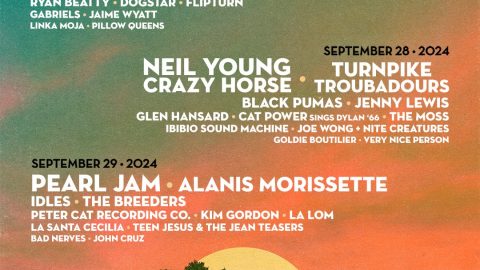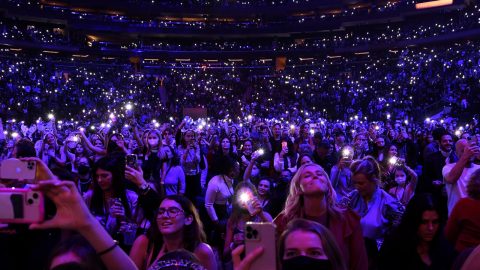The Pitch: Paging Dr. King: It’s time for another round of “Let’s Basically Do The Shining!” For the latest installment of Ryan Murphy and Brad Falchuk’s long-running horror anthology series, we settle in with the Gardners — father Harry (Finn Wittrock), wife Doris (Rabe), and daughter Alma (Ryan Kiera Armstrong) — driving to the sleepy seaside town of Providence, Massachusetts.
Harry’s a writer looking to get out of the city and cure his writer’s block; Doris, who’s expecting their second child, plans to renovate their drab vacation house in exchange for free rent. But naturally, a few things are amiss about their new home: the neighboring houses turn on red lights as the sun goes down, creepy albinos with fangs loiter around the local graveyard, and “Tuberculosis Karen” (Sarah Paulson), just one of many opioid addicts in town, rants and raves for them to get out while they can.
Before long, Harry will run into a pair of mysterious fellow artists (Evan Peters and Frances Conroy) who also vacation in Providence for inspiration. And the source of their inspiration, which they gladly share with Harry, is a lot more dangerous — and bloody — than you could ever imagine. (Not really, it’s vampires. It’s totally vampires.)
Related Video
Hole In Your Soul: At its heart, American Horror Story is camp horror pastiche at its most ostentatious: Every season, Murphy and Falchuk pay homage to everything from alien invasion stories to witch movies to tales of the apocalyptic (and, in the case of things like AHS: Apocalypse and recent spinoff American Horror Stories, itself). But so far, Double Feature — or, more specifically, this first half of the season, entitled Red Tide — feels comparatively stripped-down and simple for an AHS season.
Granted, that’s not saying much: this is still the kind of show, after all, that introduces Peters and Conroy in a bar singing a karaoke duet of “Islands In the Stream” (instantly one of the series’ most iconic moments), with all the “looking for a third” vibes that implies. Plus, Paulson’s floofy, ratty coat and pale-lipped rantings feel perfectly calibrated for the mania this show delights in supplying her.
As our window into the kooky happenings, Wittrock and Rabe are capable leads, the former with his boyish energy that can quickly give way to steely-eyed menace, the latter with her neurotic Shelley Duvall fragility that seems one setback short of a total breakdown. Armstrong, in particular, is a nifty addition to the typical AHS stable, elevating the typical creepy kid formula with a kind of internal projection of her own insecurities. Generally, the first episode (“Cape Fear”) does a brilliant, economical job of setting up the various quirks of Provincetown and the locals that inhabit it, easing us into the weirder reveals the series is set to explore.
Pale: But while “Cape Fear” offered a nicely textured introduction to the series’ broader story, episode two (“Pale”) took a steep dive into the archness that sometimes proves American Horror Story‘s greatest weakness. We quickly learn the true secrets of Peters’ Austin Sommers and Conroy’s Belle Noir — they’re vampires who take a little black pill in order to stimulate the creative juices and craft works of impeccable quality. The catch is, of course, that the pill “depletes the minerals” in their blood to do so, which means they’ve got to replenish it — take three guesses how.
The results are often deviously entertaining, a kind of sloppy but satisfying metaphor for the consumptive nature of creativity. But “Pale” spends a lot of its runtime with a recently-blackpilled Harry poring over keyboards and tedious handwringing over whether to keep up this devil’s bargain in exchange for creative genius. He also leaps way too hard into the gig for episode two, immediately seeking out a craven dentist (played by Billie Lourd) who’s willing to file Harry’s teeth down into fangs to make “the feed” more effective. (And someone, please tell Ryan Murphy that the red juice in steaks isn’t actually blood; it’s just meat’s natural juices colored by the myoglobin in mammalian muscle.)
 100vw, 1024px” srcset=”https://via.placeholder.com/590×332.png/fff?text=…”></p>
<p><noscript><img data-attachment-id=)


</p>
<p> ” data-image-caption=”</p>
<p>American Horror Story: Double Feature (FX)</p>
<p> ” data-medium-file=”https://www.mnnofa.com/wp-content/uploads/2021/08/american-horror-story-now-with-macauley-culkin-vampires-and-even-more-camp-1.jpg?quality=80&w=300″ data-large-file=”https://www.mnnofa.com/wp-content/uploads/2021/08/american-horror-story-now-with-macauley-culkin-vampires-and-even-more-camp-1.jpg?quality=80&w=780″ loading=”lazy” class=”size-large wp-image-1150097″ src=”https://www.mnnofa.com/wp-content/uploads/2021/08/american-horror-story-now-with-macauley-culkin-vampires-and-even-more-camp.jpg” alt=”American Horror Story: Double Feature (FX)” width=”100%” srcset=”https://www.mnnofa.com/wp-content/uploads/2021/08/american-horror-story-now-with-macauley-culkin-vampires-and-even-more-camp-1.jpg 780w, https://www.mnnofa.com/wp-content/uploads/2021/08/american-horror-story-now-with-macauley-culkin-vampires-and-even-more-camp-1.jpg?resize=150,74 150w, https://www.mnnofa.com/wp-content/uploads/2021/08/american-horror-story-now-with-macauley-culkin-vampires-and-even-more-camp-1.jpg?resize=300,149 300w, https://www.mnnofa.com/wp-content/uploads/2021/08/american-horror-story-now-with-macauley-culkin-vampires-and-even-more-camp-1.jpg?resize=768,381 768w” sizes=”(max-width: 780px) 100vw, 780px”></a></p>
<p id=) American Horror Story: Double Feature (FX)
American Horror Story: Double Feature (FX)








Recent Comments